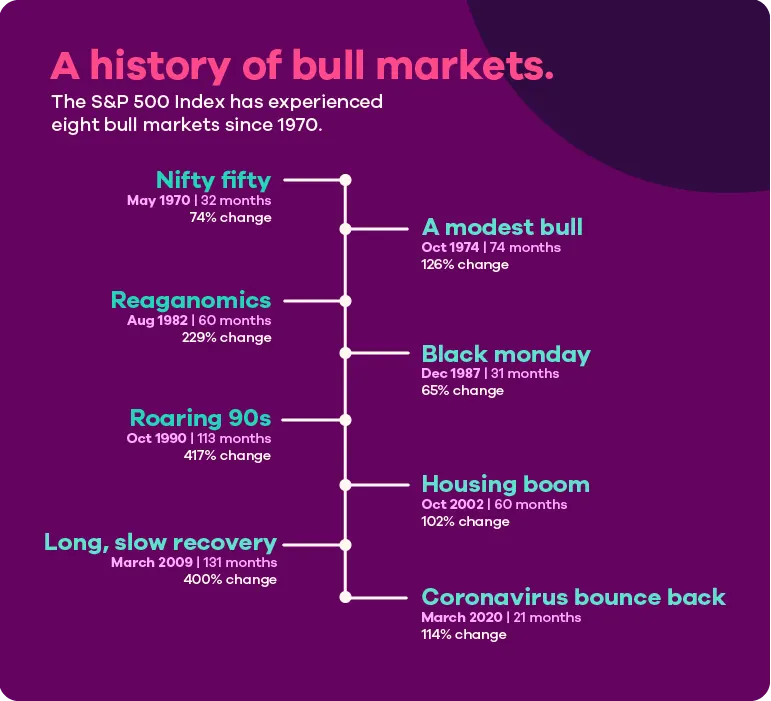What we'll cover
What the term bull market means
What a bull market looks like
How bull markets relate to the economy
When you picture a bull, you probably think of a forceful animal lunging forward with its horns held high. The imagery of a powerful bull, brought to life by artist Arturo Di Modica’s “Charging Bull” sculpture in New York City, has long been a symbol of strength and optimism on Wall Street.
So, it’s little surprise that a bull market refers to a market that is on the rise. But what does that mean, exactly? How is this different from a bear market? And as an investor, what does bullish behavior imply? Read on to take a close look at bull markets and how they differ from their opposite, bear markets.
A bull market describes a market condition when asset prices are on the rise or expected to grow.
What does a bull market mean?
A bull market describes a market condition when asset prices are on the rise or expected to grow. The phrase usually refers to the stock market but can also be applied to markets of other asset classes, like bonds, commodities or real estate.
While there’s no hard and fast rule to designate a bull market, typically, a market is considered a bull when stock prices rise by 20% or more after a 20% decline and before another 20% drop. (Bear markets, on the other hand, are defined by low investor sentiment and mark a period of a 20% or more drop in stock prices from their 52-week high.) Bull markets are long-term trends and usually last several months or years.

During a bull market, investor confidence and sentiment are high — with optimism the market will continue to yield strong results for an extended period of time. All of this means that demand for stocks is high as people are excited to invest and potentially profit. And as corporations’ profits are on the rise, the amount of IPO activity (that’s an initial public offering, or when shares of a previously private company are offered to the public for the first time) typically increases during bull markets as well.
Prior to the onset of the COVID-19 pandemic, we experienced the longest-running bull market in history, which lasted about 11 years. It began on March 9, 2009, following the lows of the 2008 Financial Crisis, and continued a strong growth trajectory over time before falling into bear market territory in early March 2020. Before that, the longest bull market began in October 1990 and lasted about 9.5 years — during which the S&P saw a 417% return.

When the economy is healthy, is there always a bull market?
The health of the economy and the movement of the stock market are closely linked. For example, when the economy is strong or growing, individuals have more money to spend. More spending means companies turn greater profits. As profits rise, so do the value of stocks, and people want in on the market — a bull market.
On the other hand, during a sluggish or hurting economy, when Gross Domestic Product (GDP) is low, unemployment is high and money is tight, consumers are less likely to spend. That means companies aren’t recording big profits. In turn, stocks may lose their value, and many people don’t want to invest: a bear market.
Just know that while the patterns of the economy and market often align, they aren’t always exactly the same. It’s possible for certain sectors, indexes or even individual assets to experience a bull market when the economy is down or vice versa. That’s because even though the economy plays a large role in the movement of the stock market, it is only one factor of many.
How does a bull market become a bear market?
ull and bear markets usually follow the economic cycle, which consists of four phases: expansion (a.k.a. growth), peak, contraction (i.e. recession) and trough. Bull markets typically coincide with the economic expansion phase.
As the economy reaches the peak phase (when market prices have been rising for a long time and investors may lose sight of the actual value of securities), an asset bubble is created. When investors feel that prices have risen too far above their actual market value, they’ll begin to drop out of the market by selling securities and taking in profits, causing the bubble to burst. As investor confidence lowers and people hurry to sell investments, prices move down, and a bear market begins to occur. This typically happens before economic contraction, or a recession, begins.
Keep in mind, not all dips in a bull market mean a bear is happening. During a secular bull market (a long-term upward facing market that is driven by large-scale trends like a healthy economy), it’s normal to see periodic, small downward movements that don’t necessarily derail the whole market. This is typically called a correction. Corrections happen when stock prices fall 10% from their most recent high. Like bulls and bears, corrections can apply to individual securities or assets, or an entire index.
Corrections usually last for an average of three to four months — and while they may be harmful to short-term investors or day traders, they can actually help the health of the market in the long run by adjusting prices that are over-inflated. Plus, they can provide you the opportunity for trading high-value stocks and other investments you might not be able to afford otherwise.
What do bull markets mean for investors?
Whether the market is a bull or a bear, investors face both risks and opportunities. The optimal time to take advantage of a bull market is early on, before stock prices have risen to their peak. While it’s impossible to predict exactly when a bull market will reach its height, many investors choose to buy and hold during an upward-trending market, with the intention of selling at a higher price later. Because the market will fluctuate during a months- or years-long bull market, some investors might look for periods of pullback or corrections to buy securities at lower prices before they begin rising again.
What is a bull investor?
Now that you’re familiar with the characteristics of a bull market, you probably have an idea of what makes someone a bullish investor or practice bullish trading behaviors. Bulls believe that stock prices will rise, whether it’s a specific security, industry or the market as a whole.
With this optimistic outlook, bulls buy stocks with the intention of selling them later at a higher price.
Opposite of bulls, bearish investors believe prices will decrease and will use strategies like short selling to profit off declines in their investments. Most investors will show bullish and bearish behaviors at times, depending on things like the market or economic conditions or based on the performance of a particular asset.
The bull-to-bear cycle
When looking at market trends and the cycles of bull and bear markets, it’s important to remember that the market can and will change on a daily basis. It’s nearly impossible to predict when a bull will turn into a bear and vice versa. So, whether it’s a current bull market or a bear that seems to be looming on the horizon, it’s often helpful to think long-term, keep the big picture in mind and stick to an investment strategy that aligns with your goals.



